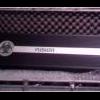-
Posts
2279 -
Joined
-
Last visited
Content Type
Profiles
Forums
Events
Media Demo
Store
Collections
Videos
Everything posted by STEvil
-

Are my subs damaged
STEvil replied to Peyton Cole's topic in Sundown Audio - GREAT Amps/Subs! GREAT Customer Service!
more volts doesnt help things, you can fry the input side of the amp or cause it to oscillate. -

Are my subs damaged
STEvil replied to Peyton Cole's topic in Sundown Audio - GREAT Amps/Subs! GREAT Customer Service!
quite possibly dead unfortunately then what has more volts than the hu? -

Are my subs damaged
STEvil replied to Peyton Cole's topic in Sundown Audio - GREAT Amps/Subs! GREAT Customer Service!
If your subs quit when you were messing with your headunit then that is part of the problem. On the headunit the output voltage signal to the amps (through the RCA's) is usually controlled by the subwoofer level. The level can be adjusted from +6 to -24. You will likely want to have this set between 0 and +3, just off the top of my head. I'd be careful if it suddenly starts working though because of how "professional" the install seems to be.. You probably either have that set incorrectly or have enabled a low pass filter or low frequency cutoff on the subwoofer output, unless the subs really are dead.. -
Finally, someone other than adire aiming for 40+..
-
Larger spiders and a surround delete (yes, I said delete) ; ) Shoot for 40mm lol
-
was wondering when i'd see the physical outcome of this What are the excursion capabilities going to be and what are prices looking to be?
-
What do you think would be more fun, 2x EMF 15's or 4x Zv4 10/12's?
-
it wont. Not any more then scoping your amp would. Honestly, to NOT believe in the DD-1 is to not believe in an O-scope. Our product does what a scope is supposed to do, but does it faster and more accurately. Regardless, I wouldn't mess with any shop or installer that doesn't use an O-scope in the very minimum. Also it does it simply and cheaper than the average scope, cant beat that btw Steve sorry if it seemed my last post was knocking on you, not my intention.
-

Camaro Abuse - This is what REALLY happens at the dealership
STEvil replied to meade916's topic in Vehicles In Motion
I found another copy I think. http://www.youtube.com/watch?v=CkOaSEy4l6k -

Camaro Abuse - This is what REALLY happens at the dealership
STEvil replied to meade916's topic in Vehicles In Motion
Video taken down, anyone got a link to another copy of it? -
To a point. Some can take it, some cant.
-
Here is some good info. As for processors, extra voltage is OK since you have far more diverse and powerful cooling options than you do with an amp. Depends on the process used for the processor. Some are high leakage, some are low, and cooling doesnt change electromigration until you get near to the point of superconductivity of the silicon used to make the CPU.. if you can get there without hitting a "cold bug" point first.
-
Max out your dimensions (~3ft each), tune to 30-33.
-
You mean a large turbo with a small motor, but no that analogy doesnt work if you understand it really. The components are meant to work at a certain voltage (12-18 as mentioned before) and if used at that voltage they will consume a known amount of current (amperage) to produce a known amount of output power. With current regulated amplifier technology this is controlled by cycling the mosfets on and off to create a steady amount of power for the second half of the amplfier. Less voltage means the controller of the mosfets cycles the "on" time longer which means the mosfets build up more heat. Heat creates resistance which means the fet controller must cycle the fets longer again which can create further voltage drop.. which means longer duty cycles... This is known as a "thermal cascade" and as you can see it is not the voltage that is the actual death culprit but just a factor that drives the issue. High voltage can kill an amplifier by creating what is known as electron migration. Basically arc (stick) welding inside the electrical components. Computer processors are an example of something that is very suceptible to this - hence why overclocking with increased voltage has the possibility to degrade or destroy processors. Pentium 4's were great examples of this
-
"just picking" is my guess edit - and given his responses my hedge on the hard clip seems pretty close.


